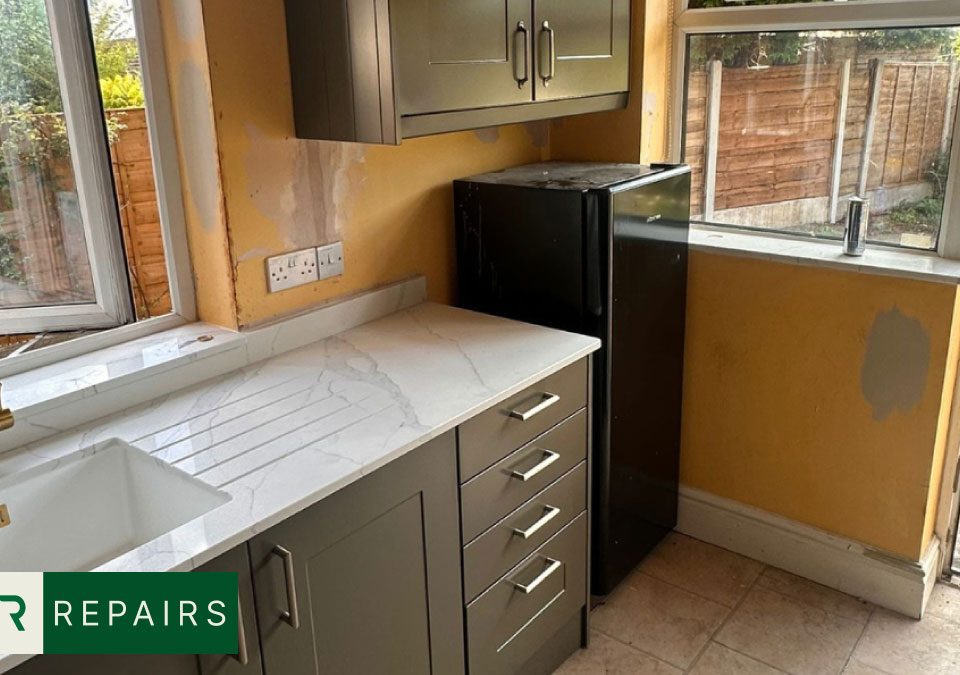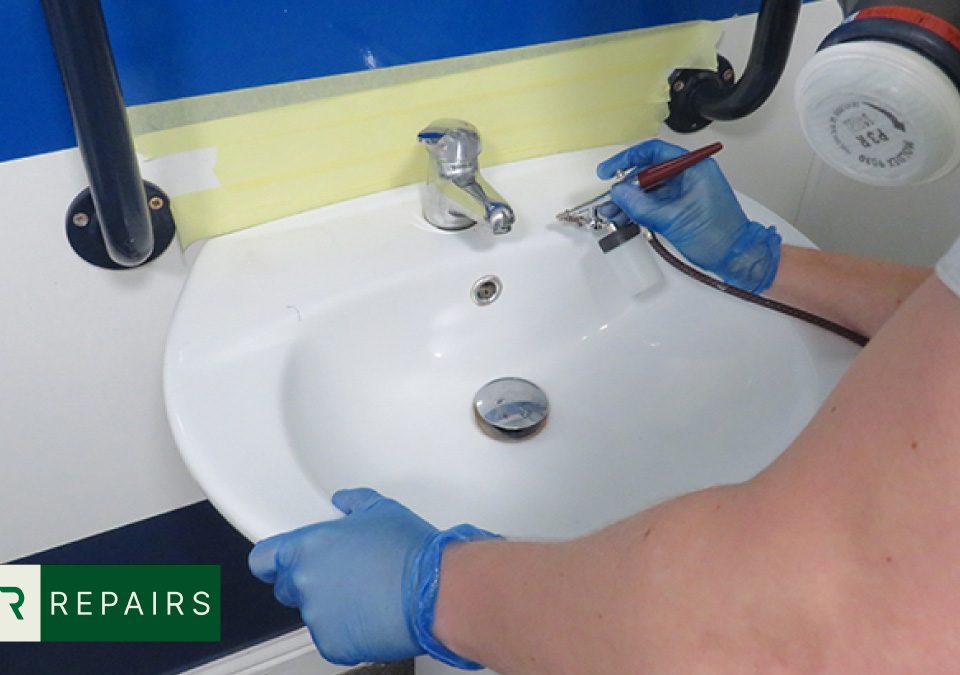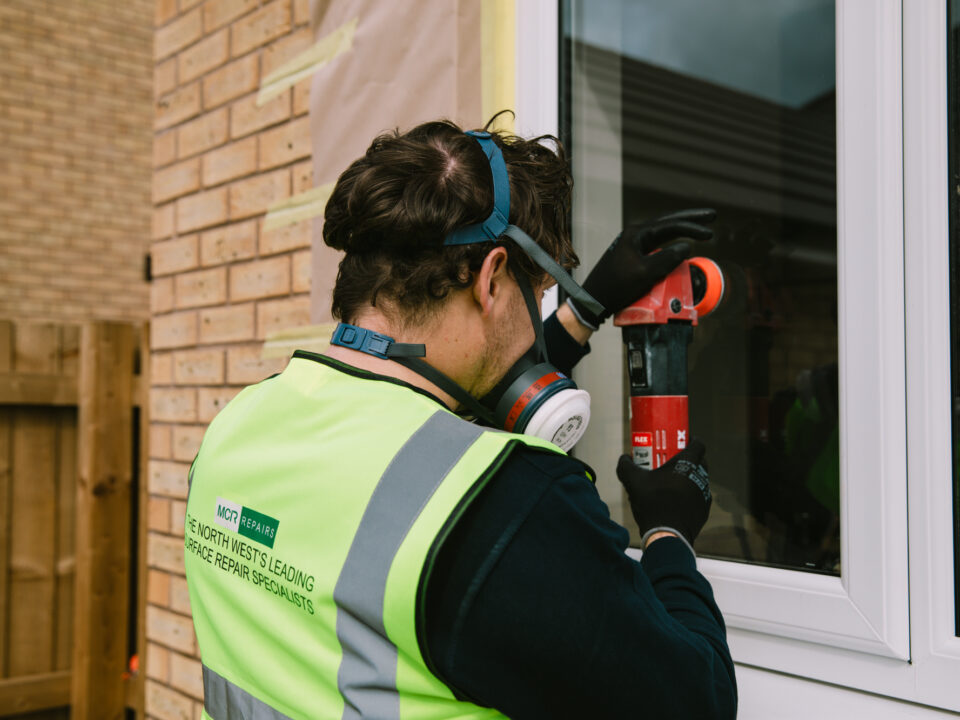A good chipped-bath repair service will get your bath looking good as new. At MCR Repairs, we always say why repair when you can replace.
The truth is most bath damage can be repaired, and we always ensure the results look good as new when done right.
Whether you should do-it-yourself or get a proffessional to handle it, this guide will help you understand when you can fix a chipped bath yourself and when to call in a bath and sink repair professional.
Understand Damaged Bath Types and Solutions
Not all bath damage is the same. What you’re dealing with makes a big difference to whether you can repair it yourself or need expert help.
Small Chips and Scratches
These are the most common problems. Something drops on the bath edge and takes a small piece out. Or you get surface scratches from cleaning or daily use.
Small chips are usually fixable at home if the bath material underneath is still sound. Surface scratches can often be polished out without any filling needed.
Cracks
Cracks are more serious. They can let water seep through to the area underneath, which causes mould, rot, and structural damage over time.
Small hairline cracks might be fixable with the right products. Larger cracks that go right through the bath material usually need professional repair. If left alone, they will only get worse.
Large Chips or Holes
These happen less often but are harder to fix. They expose a bigger area of the base material and need more work to fill, smooth, and colour match properly.
Large damage almost always needs a professional. DIY kits struggle to give good results on anything bigger than a five pence piece.
Rust Spots
If you have an enamel bath over metal and the enamel chips away, rust can start underneath. The rust needs removing before any repair work happens, or it will spread and ruin the fix.
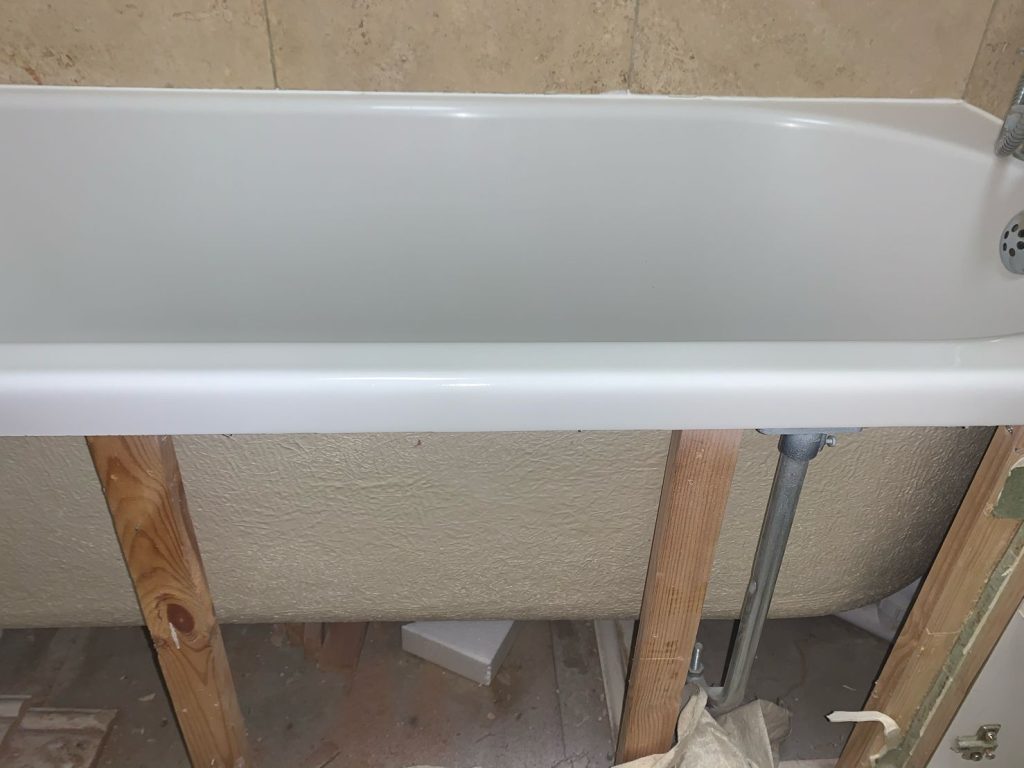
What Type of Bath Do You Have?
The repair method depends on your bath material. Get this wrong and your repair will fail.
Acrylic Baths
These are the most common type in modern homes. They’re lightweight plastic baths, often reinforced underneath with fibreglass.
Acrylic is the easiest material to repair. Specialist acrylic repair kits work well for small chips, and professionals can make repairs almost invisible.
The fridge magnet test works here. If a magnet doesn’t stick to your bath, it’s acrylic or fibreglass.
Enamel Over Steel or Cast Iron
Older baths often have a porcelain enamel coating over metal. These are heavy, solid baths that were built to last decades.
A magnet will stick to these baths. The enamel itself is hard and durable, but once it chips, the metal underneath can rust. Repairs need special enamel repair products, not acrylic ones.
Stone Resin Baths
These are high-end baths made from crushed stone mixed with resin. They look like natural stone but are moulded into shape.
Stone resin can be repaired, but the results are often more visible than with other materials. Matching the colour and texture takes real skill. Stone repairs usually cost more because of the specialist products needed.
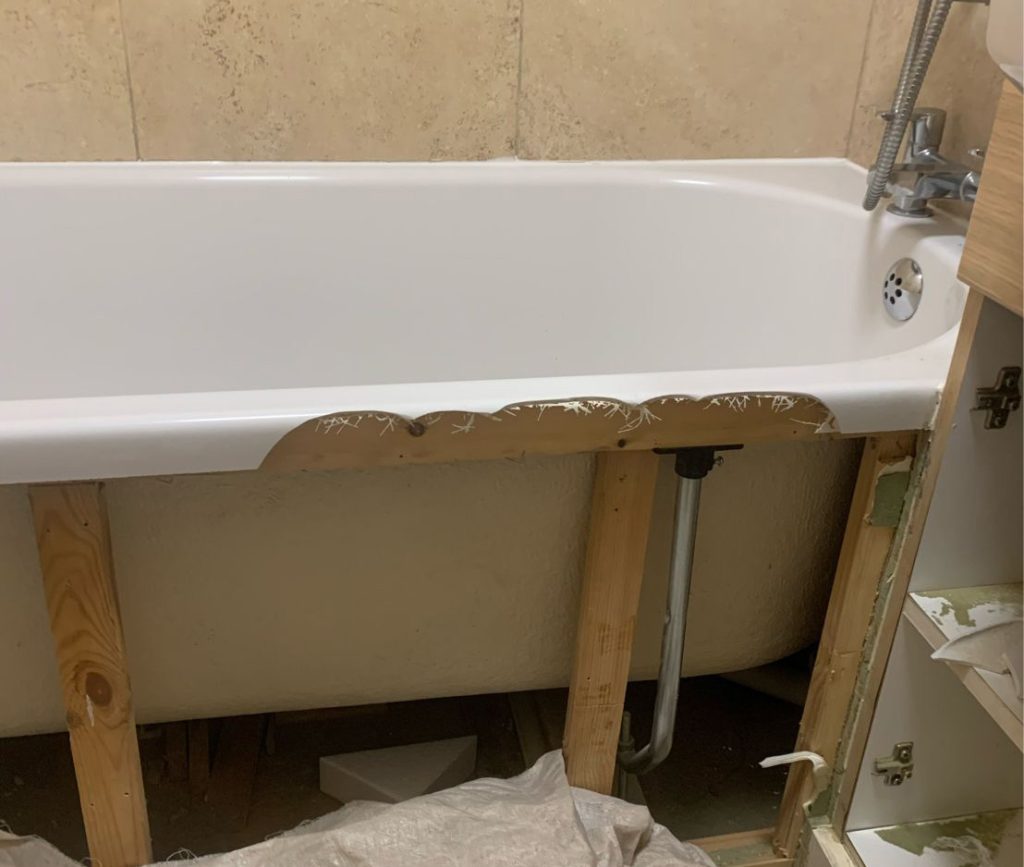
When Can You DIY a Bath Repair?
DIY bath repair makes sense for small, straightforward damage. Here’s when you can tackle it yourself.
Perfect for DIY
- Small surface chips under 10mm across work well with DIY kits. The damage should only affect the top layer, not go right through the bath material.
- Surface scratches that haven’t gone deep can often be polished out. Light scuffs from general wear respond well to cream cleaners and gentle buffing.
- Minor cosmetic marks like staining or discolouration can be cleaned with specialist bath cleaners before you consider repair work.
DIY Limitations
- Even good quality DIY repairs rarely last as long as professional work. Most home repairs hold up for one to three years before they start to show wear or fade.
- Colour matching is the biggest challenge. Repair kits come in standard white, but baths fade over time. Your patch might look perfect when wet but obvious when dry.
- If the damage is on a vertical surface or the bath side, keeping filler in place while it sets is tricky. It tends to sag or run before it hardens properly.
When to Call a Professional for Bath Repair
Some repairs need professional skills and equipment. Here’s when to contact a professional instead of picking up a repair kit.
Structural Damage
Any crack in your bath needs professional assessment. Even small cracks can spread and let water through. Water damage to floors and ceilings costs far more to fix than calling in an expert straight away.
If your bath flexes or moves when you stand in it, there’s a structural problem underneath. This won’t be fixed by patching the surface.
Large or Multiple Chips
Once damage covers more than a few centimetres, DIY repairs start to look obvious. Professionals have the tools to blend repairs seamlessly across larger areas.
If you have several chips or damaged spots, professional resurfacing might make more sense than multiple small repairs.
High-End or Vintage Baths
Designer baths in unusual colours or finishes need expert colour matching. Stone resin, ceramic, freestanding baths, and vintage cast iron pieces are too valuable to risk with DIY repairs.
If your bath cost over a thousand pounds when new, protect that investment with professional repair work.
When Aesthetics Matter
If the damage is in a visible spot that you’ll see every day, professional repair gives far better results. DIY repairs often work fine but rarely look invisible.
For rental properties or homes being sold, professional repairs hold up better to scrutiny from tenants or buyers.
Professional Chipped Bath Fix & Repair Process
Professional bath repair follows careful steps to make damage disappear. Here’s what happens when you call in the experts.
Inspection and Assessment
The technician looks at the damage and checks the bath material. They’ll tell you if repair is possible or if the damage is too extensive.
They’ll also check for any hidden problems like cracks you haven’t noticed, or water damage underneath the bath that needs fixing first.
Surface Preparation
The damaged area gets thoroughly cleaned to remove all soap residue, body oils, and old cleaning products. Any rust gets removed and treated.
The area around the damage is lightly abraded to give the repair materials something to grip onto. This step matters more than many people realise.
Filling and Building
For chips and holes, a specialist filler gets mixed and applied. This might be epoxy for acrylic baths, or enamel compounds for metal baths.
The filler is built up in layers if needed, making sure each layer bonds properly. Vertical repairs use special techniques to hold the filler in place while it sets.
Colour Matching
This is where professional repair really shows its value. Technicians mix colours on site to match your specific bath, not just “white”.
Good colour matching takes into account how your bath has faded over the years. The repair needs to match the current colour, not the original factory finish.
Smoothing and Finishing
Once the filler has hardened, it gets sanded smooth and level with the surrounding surface. Different grades of abrasive paper are used, working from coarse to very fine.
A final polish brings back the shine and blends the repair into the existing surface. One type of polishing that can give you that smooth finish is french-polishing.
Sealing and Protection
Many professional repairs include a protective coating that helps the repair resist water, soap, and wear. This makes repairs last longer.
The repaired area needs time to fully cure before you can use the bath again. Most repairs need 24 to 48 hours of curing time.
How Much Does Bath Repair Cost?
Professional bath repair costs vary based on the damage and your location. Here’s what you can expect to pay in the UK.
Small Chip or Scratch Repairs
Single chip repairs typically cost between £80 and £150. This covers one visit from a technician who will repair one or two small chips in the same area.
The price includes materials, labour, colour matching, and usually a guarantee on the work. London and the South East tend to be at the higher end of this range.
Crack Repairs
Fixing cracks costs more because of the extra work involved. Expect to pay £150 to £250 for crack repair, depending on the length and location of the crack.
Cracks on the bath base are easier to fix than cracks on vertical surfaces or around corners.
Multiple Repairs
If you have several chips or damaged areas, many companies offer a better rate than charging for each one separately. Multiple repairs in one visit often cost £175 to £325.
Full Bath Resurfacing
When damage is extensive or the whole bath surface has dulled and worn, full resurfacing makes more sense than spot repairs. This costs £425 to £485 plus VAT.
Resurfacing involves applying a complete new coating to the entire bath surface. The finish should last 10 to 15 years with proper care.
How Long Do Bath Repairs Last?
The lifespan of a bath repair depends on the quality of work and how you care for it afterwards.
Professional Repairs
Good professional repairs typically last five to ten years or more. The repair should wear at roughly the same rate as the rest of the bath surface.
Full bath resurfacing can last 10 to 15 years, which is often enough time to get another decade from an otherwise tired bath.
DIY Repairs
Home repairs using quality kits usually hold up for one to three years. The repair material itself is durable, but home application rarely achieves the same bond strength as professional work.
The visible difference tends to become more obvious over time as the repair ages differently to the original bath surface.
Caring for Your Chipped Bath After A Fix
Once repaired, your bath needs gentle care to keep the fix looking good.
Avoid Abrasive Cleaners
Harsh scouring powders or abrasive cream cleaners can damage both the repair and the original bath surface. Stick to gentle bathroom cleaners.
Magic sponges work well for most bath cleaning but can wear down repairs faster than the surrounding surface if used too often on the repair site.
Clean Regularly
Don’t let soap scum, limescale, or dirt build up on repaired areas. Regular cleaning with mild products keeps the repair looking better for longer.
Rinse the bath after each use to prevent product buildup. This simple habit extends the life of repairs significantly.
Watch for Early Warning Signs
Check repairs every few months for any signs of lifting, cracking, or colour change. Catching problems early means they can be fixed before they get worse.
Small touchups are far cheaper than letting a repair fail completely and having to start again.
Why Choose MCR Repairs for Bath Repair
We’ve been repairing baths, sinks, and other hard surfaces across Manchester and the North West for years. Our technicians know what works and what doesn’t. Here’s why we’re the best team for your repairs.
- Our team holds NVQ Level 2 qualifications or higher in damage repair and resurfacing. Also, we work with major construction companies, housebuilders, and homeowners. That experience means we get it right first time.
- We use professional-grade repair products that last. Our colour matching is done on site to match your specific bath, not just pulled from a standard range.
- We give honest quotes with no hidden fees. If we think your bath is beyond repair, we’ll tell you.
- Our repair work comes with a 12-month warranty, subject to our aftercare terms. That’s our confidence in the quality of work we provide.
Get Your Chipped Bath Fixed Today
A chipped bath doesn’t mean panic or huge expense. Most damage can be repaired properly for a fraction of replacement cost.
If you’re dealing with a small chip and feel confident tackling it yourself, a quality repair kit might do the job. For anything larger, or if you want results that last, professional repair makes better sense.
We’re based in Manchester and cover the entire North West. Whether you need a single chip repaired or full bath resurfacing, we can help.
Call us on 0161 241 6888 or email Sales@mcrrepairs.co.uk for a free quote. Send us a photo of the damage if you can, and we’ll give you an honest assessment of what’s needed.
Your bath can look as good as new again. Let us show you how.
FAQs: Bath Repair
Can All Types of Bath Damage Be Repaired?
Most surface damage can be repaired by professionals. Small chips, cracks, scratches, and even small holes usually respond well to expert repair. Very large damage or baths with multiple structural problems might be beyond economic repair.
Will the Repair Be Visible?
Professional repairs done well are hard to spot, especially on white baths. Coloured baths are trickier because colour matching takes real skill. DIY repairs are usually more obvious but still much better than leaving the damage as is.
How Soon Can I Use My Bath After Repair?
DIY repairs usually need 24 hours to cure fully before the bath can be used. Professional repairs might need 24 to 72 hours depending on the products used and the extent of work done. Always follow the specific advice from your repair technician.
Do Bath Repairs Come With Guarantees?
Most reputable professional bath repair companies offer guarantees ranging from one to five years on their work. Get this in writing before any work starts. DIY repairs obviously don’t come with guarantees beyond the repair kit manufacturer’s product guarantee.
Can I Repair My Bath If It’s Already Been Resurfaced Before?
Yes, but it depends on the condition of the previous resurfacing work. If the old resurfacing is flaking or peeling, it might need stripping back to the original bath surface before new repairs can be done. This adds time and cost to the job.
What If the Chip Has Rust Underneath?
Rust must be completely removed and treated before any repair work happens. Professional repair technicians have the right products to neutralise rust and stop it spreading. Trying to patch over rust without treating it first means the repair will fail quickly.


